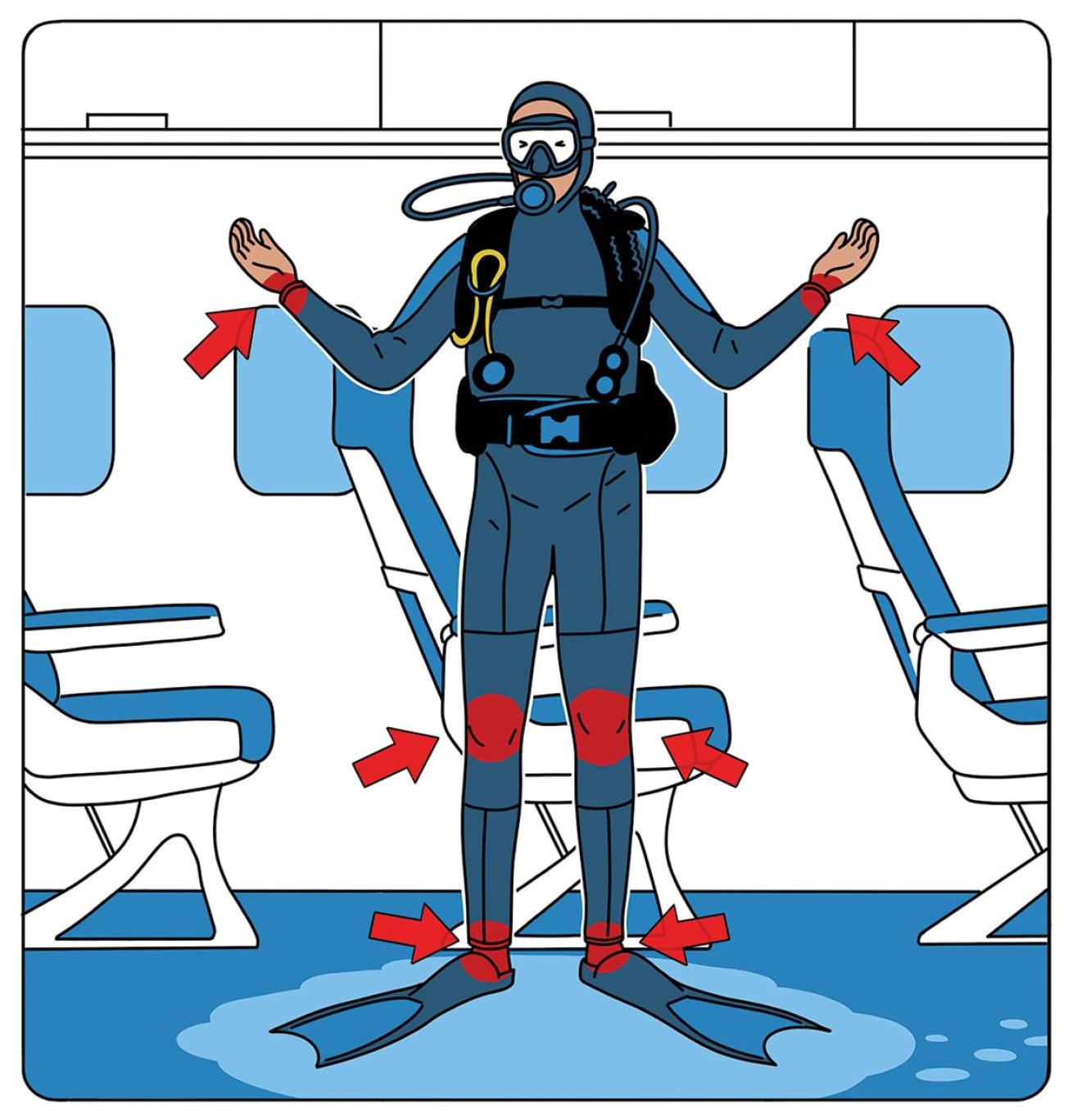
As a normal guideline, divers ought to wait 12 hours or extra after a single no-decompression dive earlier than flying and not less than 24 after a compulsory deco dive.
Steven P. Hughes
Zack hadn’t made lots of dives since he was licensed the earlier summer season, however he was taking full benefit of the chance on this household trip. He was the one member of his household who was licensed, however his mother and father let him take a day away on his personal. He beloved the 4 dives he made with a divemaster, however when he wakened the following day, Zack was feeling a bit tough. He had no identified medical circumstances.
The Dives
Anticipating solely someday of diving on this household journey, Zack deliberate to profit from it—signing up for morning and afternoon dives with a neighborhood constitution boat. His first dive was to 50 ft for 35 minutes. About 45 minutes later, he made a second dive to 30 ft for half-hour. On every dive, Zack made a two-minute security cease.
His morning dives concluded, and so they headed again to shore for lunch. By the point he was on the second boat experience again to the following dive web site, Zack’s floor interval was roughly 5 and a half hours.
His third dive was to 50 ft for 35 minutes with no security cease. He made a rapid turnaround, simply lengthy sufficient to change out his tank, and was again within the water for one more 50-foot dive for half-hour. He completed off that dive with a three-minute security cease. Zack reported no issues on any of the dives.
The Accident
The following morning, Zack wakened feeling off. He had gentle joint aches that acquired worse all through the day. The feeling was concentrated in his palms, knees, ankles and ft. He didn’t really feel nicely the remainder of the day and mentioned he had by no means skilled something like this earlier than. The following day, Zack flew house along with his household.
It was virtually two full days since his final dive, and a day and a half after he first seen the pains. In the course of the flight, the ache intensified, and he seen some swelling in his legs and arms. Zack’s mother and father took him to the native hospital emergency division once they acquired house. A physician educated in diving drugs identified him with decompression illness and advisable a five-hour U.S. Navy Remedy Desk 6 in a hyperbaric chamber. The following day he had a follow-up two-hour remedy; his signs improved over the next week.
Evaluation
There isn’t any definitive check that reveals a diver has DCS. It will probably solely be decided based mostly on the current historical past of diving and the onset of signs— usually these signs present up inside six hours, though longer durations will not be unusual.
In Zack’s case, he first seen the presence of signs about 12 hours after his final dive. In fact, he was asleep for a great portion of that point. A few of the key figuring out components within the prognosis of DCS embody ache that doesn’t change with motion and recognizing it’s ache that you’ve by no means felt earlier than.
You may need an occasional ache in your shoulder, but when the ache feels totally different after diving and the feeling doesn’t change whenever you transfer your shoulder round, that could be a pink flag that it could be diving-related.
About 42 hours after his final dive, Zack boarded an airplane. Beneath regular circumstances, that might be loads of time to let the surplus nitrogen in your physique off-gas, however on this case, Zack had untreated signs that have been exacerbated by the flight.
Business airplanes are pressurized, however they don’t seem to be pressurized to sea-level pressures. Typical cabin stress is ready to between 6,000 and eight,000 ft. That’s the equal of driving up a really steep mountain in a short time and staying at that elevation for hours.
Basic tips for flying after diving state that divers ought to wait 12 hours or extra after a single no-decompression dive earlier than flying. They need to wait greater than 18 hours after multiday or repetitive no-decompression dives. When you’ve made a compulsory decompression dive, you need to wait greater than 24 hours earlier than boarding an airplane.
After Zack’s first remedy, there was little or no change in his signs initially. He skilled a bit extra enchancment the following morning after the second, shorter remedy after which the signs totally resolved over time.
This isn’t unusual in relation to DCS. Ideally, DCS must be handled straight away. The delay in remedy—a day and a half after the signs first introduced themselves—made Zack’s accidents tougher to deal with, and slower to heal.
Signs of DCS Embrace:
| Gentle | Muscle or joint ache; Pores and skin rashes, mottling or swelling; Tenderness, particularly across the pores and skin; Gentle fatigue |
| Extreme | Numbness, tingling and muscle weak spot; Problem strolling or lack of coordination; Confusion; Vertigo; Chest ache or issue respiration; Bladder or bowel dysfunction; Tinnitus or listening to loss |
Classes For Life
- Acknowledge the signs. The signs of DCS will be refined, and the commonest symptom of DCS is denial. Study to acknowledge indicators and signs, and search assist instantly whenever you discover them.
- Coaching. Get educated in oxygen first-aid. Immediate administration of one hundred pc oxygen after signs current themselves can velocity therapeutic and cut back long-term issues.
- Search medical assist. While you consider you may have signs of DCS, seek the advice of a doctor educated in diving drugs or name the DAN hotline.

